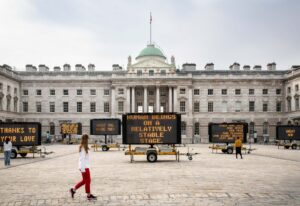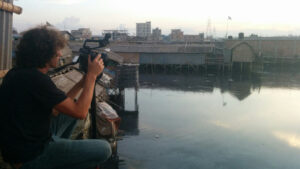
Justin Brice – Environmental Artist
Environmental artist Justin Brice encourages others to take a critical look at the relationship between humans and the planet.
MOOD OF LIVING
Growing up in Los Angeles and now living in Water Mill, NY, Eric Dever, American fine artist, analyzes and experiments with material and hues, as well as stillness and movement.
In his recent collection of compelling works, Dever’s paintings break through what is stationary and radiate in liberating motion. As Dever says himself, “…while the grid still resides within, each painting emerges into free shapes and tactile surfaces.” Like a rose, which was the inspiring origin of these artworks, the creations flourish.
Eric Dever discovers the intriguing varieties of texture and embraces the boundless possibilities of the extraordinary spectrum of color.
MoL: Occupation?
Eric Dever: Fine Artist, Painter
MoL: Occupation description?
ED: I am responsible to myself for everything that has to do with the creation of my paintings: maintaining a studio and an environment conducive to art making, building supports and preparing surfaces, extending the frontiers of my artistic experience and thought.
MoL: Before your current occupation you were?
ED: I have always self identified as an artist, a painter, and have organized my life around that objective. In the past, I have supported myself with a number of part time jobs, which have been both broadening and humbling.
MoL: What and/or who inspired you to become an artist?
ED: Art, music, and theater were highly valued and part of the curriculum in the Los Angeles Unified School District in 1966. They were required courses in middle and high school, and this kept gifted students on the path. My art experience growing up has helped me develop a sense of self and a deep interior life.
MoL: Where and how did you learn your craft?
ED: Painting is something I always gravitated toward. By the time I was a junior in high school I had a full art program, studying with a remarkable teacher, Mary Jane Casey, a student of Corita Kent, pop artist. I let my family know that this was going to be my profession and went forward studying drawing in an artist’s studio in Venice Beach. I received a full summer scholarship at Otis/Parsons near MacArthur Park, and as soon as I was old enough to drive, I began visiting museums and galleries. In 1986, I was accepted to New York University (MA’89-studio art) where I concentrated on painting and critical theory.
MoL: What medium do you like to work in?
ED: I prefer oil paint, emulsified wax, turpentine. These are largely organic materials and take time to dry. The pause between layers and range of consistencies suits me well, and the results are personally satisfying, lustrous and luminous.
MoL: How would you describe your artwork? How would you describe your creative process?
ED: Recent paintings are explorations through and beyond formal inquiry. The paintings in this current exhibition at Berry Campbell Gallery in NYC are a dramatic breakthrough; while the grid still resides within, each painting emerges into free shapes and tactile surfaces achieved by work with brush and knife. The starting point for this suite of paintings was a rose from the garden, which I deconstructed, letting the energetic qualities of color, line, and form emerge, presenting discoveries of richer more rare hues—especially red.
MoL: Where do you look for inspiration?
ED: Inspiration seems to arrive when I’m ready. It comes out of curiosity, a persistent thought—something I’d like to see or try in a painting.
MoL: It says on your personal site that you are now working with the colors “Naphtol Scarlet Red, Titanium White and Ivory Black.” What is it about these 3 specific colors that intrigue and motivate you as an artist? Why is color, in general, such an important part of an artwork?
ED: For a decade, I’ve been focused on a palette of white, red, and black, exploring outcomes which vibrate between stillness and action, lightness and weight. In an exciting sense—color becomes material itself.
MoL: What is your favorite quote?
ED: Vouloir, c’est pouvoir. If you wish, you are able.
MoL: How do you achieve a peace of mind and spirit?
ED: I’ve been practicing and studying Ashtanga yoga for nearly six years. This strengthens and purifies the body, but most important quiets the mind; in this respect drawing and painting are considered yogic arts.
MoL: We find that people who make beautiful things are more likely to lead an artistic lifestyle: Do you spend much time creating a beautiful home?
ED: My living space is an expression of my priorities. Furnishings are simple, functional and well designed. Paintings rest on a portion of the walls.
MoL: What is your favorite hobby?
ED: I’ve enjoyed caring for these roses especially while they are blooming, and have helped out with feral cat trap-neuter-release (TNR) programs, including 2 managed colonies. It’s easier than it seems and helps prevent needless suffering.
MoL: Who is an influential figure in your life?
ED: Josef Albers. His experiments with relative color, paintings, books, have shown me how exciting color can be, pointing me towards my own experiments and exploration.
MoL: If you could have a conversation with any artist of the past or present, who would it be and why?
ED: Again, Josef Albers. First, I would have liked to been his student at the Black Mountain College and to participate in his color exercises and critiques. His books, “The Interaction of Color,” “Formulation:Articulation,” and the recent Morgan Library catalogue, are valuable legacies, but interaction imparts another kind of knowledge or intelligence.
MoL: What period of art do you most admire?
ED: The 20th century ascendency of Modernism and its critique. We’re still suffering the consequences of that brilliant and cruel century.
MoL: When was the moment you realized you could really do this?
ED: t’s been exciting from the very beginning, dipping a brush into a cutdown milk carton or tin can half filled with reconstituted dry tempera paint in front of a simple easel with newsprint paper clipped at the top. My mother was a teacher and her classroom fascinated me—it goes back as far as I can remember.
MoL: It says on your personal site that “the subject of [your] work [has] been an examination of the methods and materials of painting.” Where has this examination led you as an artist? What discoveries have you made and what do you still hope to discover through this examination?
ED: Nearly a decade ago, I limited my palette to white—Zinc and Titanium white, which enabled me to uncover a white spectrum ranging from opacity to translucency. These compositions were largely geometric, including circles graded from dark to light, which included the introduction of black, widening the range and force of the work. In 2010, I began testing prepared red hues and arrived at Napthol Scarlet, a modern replacement for Vermillion, and worked through some of the earlier compositions. The range and quantity of tones were staggering, all from just red, white, and black. Relative color, so eloquently presented and discussed by Josef Albers, was apparent in this work as background painting incrementally became foreground with a second coat of evenly spaced and graded strokes or bars of color, including—a pulsing metallic quality, made visible as similar values of opposite tones are placed alongside. This has become my recent departure point.
MoL: Where do you see yourself in 10 years?
ED: Where I have always seen myself, painting as I do now, making new discoveries and innovations in the work— growing. I am working with Berry Campbell Gallery who is currently organizing a museum show in an academic center. I’m also ready for a mid career retrospective and a monograph. I love teaching and sharing this experience with others.
MoL: What is the message you hope to project through your artwork? What feelings do you hope to convey?
ED: If my paintings could help someone to pause, look, ultimately discovering in themselves an ability to see and understand something new, that would please me, although I do not seek such outcomes.
MoL: What advice can you give to anyone interested in becoming an artist?
ED: If you have a vision and you’re willing to do the work, it will bear your mark and carry you forward.
Photography courtesy by Eric Dever

Environmental artist Justin Brice encourages others to take a critical look at the relationship between humans and the planet.

Internationally recognized filmmaker Andrew Morgan focuses on telling stories for a better tomorrow for various film and new media projects.

Throughout his work with Ala Plástica and Casa Río Lab, environmental activist and artist Alejandro Meitin unites social engagement, art, and sustainability.